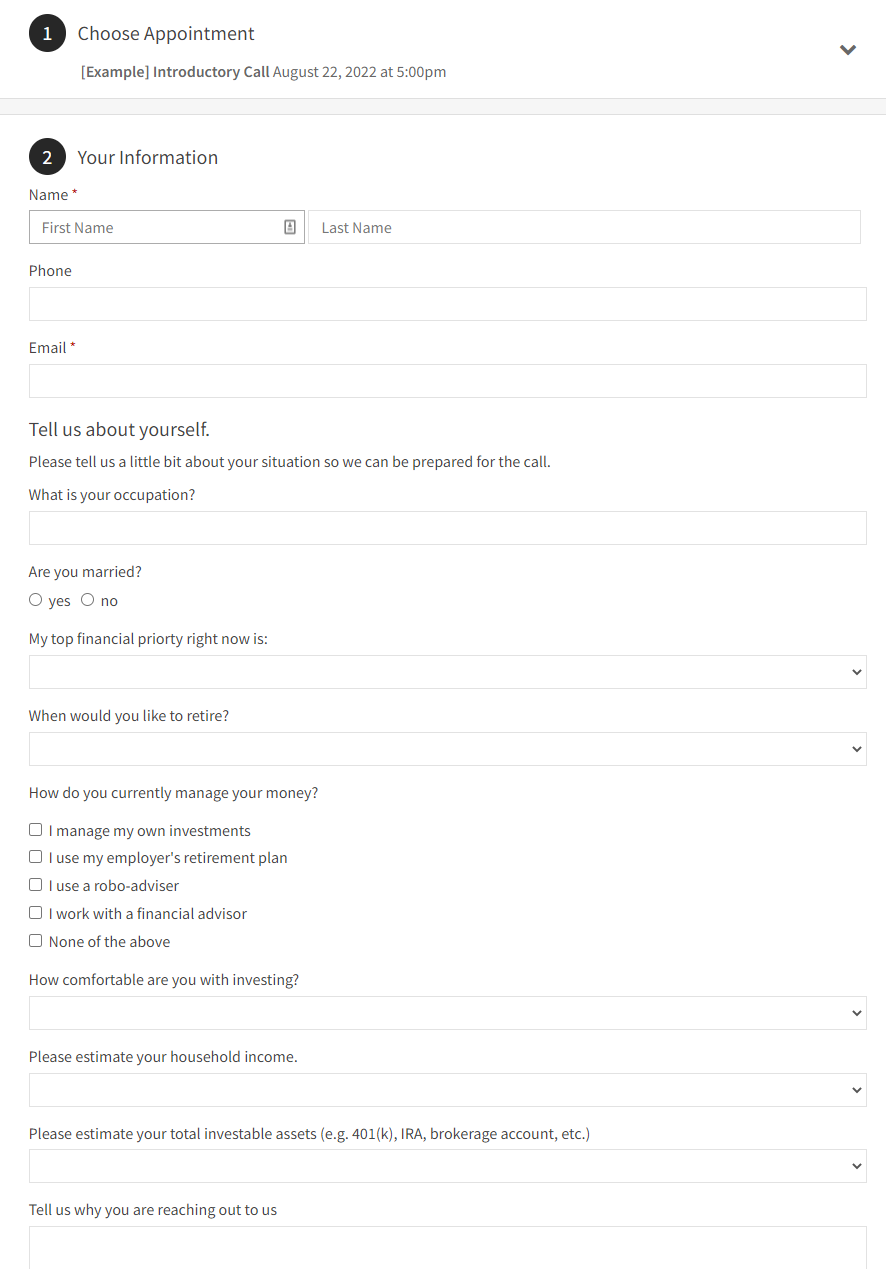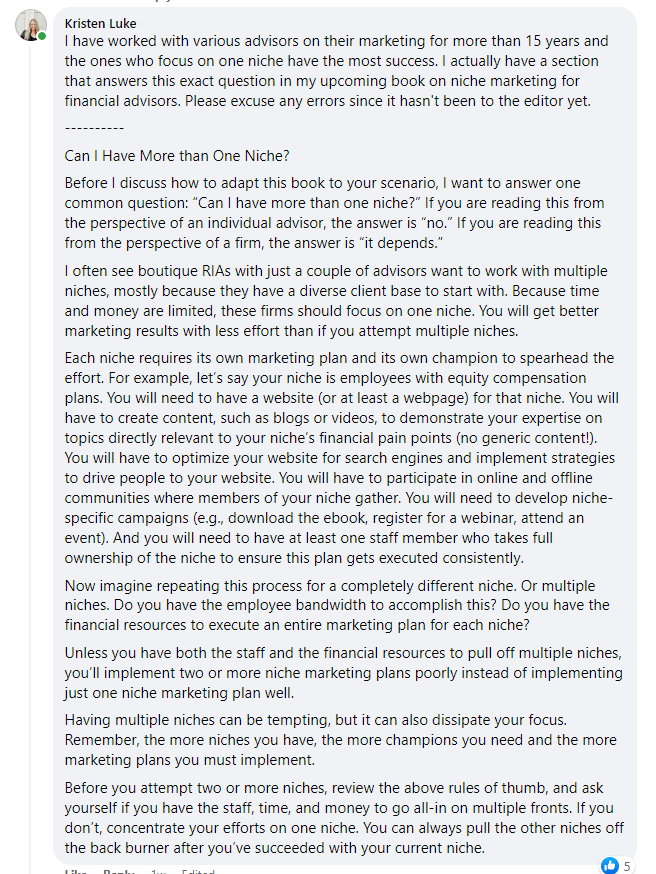How to Utilize LinkedIn Articles and Newsletters
How to Import a CTA Badge into Your Blog
How to Qualify Prospects
As you achieve success with your niche, you’ll get unsolicited leads from your website. Prospects with no previous connection to your company will find your website through Google and schedule an appointment using your calendaring system. But once this happens, you’ll find that most web leads don’t meet the minimum requirements to become a client.
When you get only a few website leads per month, talking to a few unqualified prospects needing some quick advice doesn’t seem like much of an inconvenience. It may even feel like you are doing a good deed. But when you start getting dozens of web leads, you quickly learn the frustration of having your calendar filled with unqualified leads.
To solve this problem, use your calendaring software to ask basic qualifying questions. That way, before you even have a call, you can quickly identify the people who are clearly not a fit and refer them to an advisor who would be a better match. Many scheduling software systems allow you to add custom questions to gather this kind of qualifying information. Follow these guidelines when building your questionnaire.
Basic Information
When setting up qualifying questions, set the stage for why you are asking so many personal questions. We like to start by saying, “Tell us a little bit about your situation so we can be prepared for the call.”
Then ask some basic questions like:
What is your occupation?
What is your age?
What is your marital status?
When would you like to retire?
Financial Priorities
Next, ask about their top financial priority to begin to understand if they will be a good fit. Give the prospect some options to choose from, such as:
Planning for my retirement
Planning for the sale of my business
Saving for a major purchase or event
Investing my money
Rolling over investments from a previous employer
Investing an inheritance
Taking control of my finances after a life-changing event (e.g., divorce, death of a spouse, marriage)
You should customize these options to include the priorities that focus on the specific pain points of your niche. You should also have an “Other” option where they can fill in their own answer.
Investment Experience
Next, consider questions to understand their experience with investments and financial advice. It is helpful to know if they see themselves as a novice or an expert, a DIYer or a delegator. Questions you could include are:
How do you currently manage your money?
How comfortable are you with investing?
Financial Situation
Next, ask questions that reveal whether they meet your financial minimums. This is important information to know to refer out nonqualified prospects if it is obvious you can’t help them. Queries to financially qualify your leads include:
Estimate your household income.
Estimate your total investable assets.
Estimate your total net worth, including real estate and businesses.
Make these questions easy to answer by providing a range for each query instead of requiring the prospect to give exact amounts.
You will want to set up your ranges so you can immediately identify if the prospect is qualified. The first range should be someone who absolutely won’t qualify. Let’s say your stated minimum account size for investable assets is $500,000, but you are flexible if they are high-earning prospects. In this case, you may know that you won’t take anyone with less than $250,000. So “Less than $250,000” would be the first range—the unqualified range.
The next range is for people who are not currently qualified, but you may be flexible about working with them under the right circumstances. In this case, it is people with more than $250,000, but they still don’t meet your minimum of $500,000. You will need to look at their answers to your other questions to see if it makes sense to schedule the introductory call.
The next range is for someone who would be solidly qualified but maybe isn’t what you would consider ideal—for example, $500,000 to $1 million.
The next range is for someone who fits your ideal client’s financial profile. Let’s say $1 million to $5 million in investable assets.
And the final range is for someone who is beyond your ideal client profile. Some firms would love to have clients in this last range. Other firms may use that information to disqualify prospects because their financial situation may be too complex for the services the firm offers.
OPEN-ENDED
At the end of the questionnaire, you’ll want to ask, “Tell us why you are reaching out,” so the prospect can explain, in their own words, why they’re scheduling an appointment. Their response can really help you understand if they are a good initial match. It will also give insight into whether the prospect anticipates a windfall that would make them qualified in the near future even though their current answers don’t.
Marketing Source
Finally, you should ask how they heard about you to track your marketing efforts.
When you establish this process, you might make filling out the fields optional so that you don’t discourage people from contacting you. Our experience is that even if the fields are not required, most prospects will complete the form, especially if they are serious about hiring a financial advisor.
If you currently qualify your leads by phone, use the same questions on your call as you would on the website.
How Do I Interact in Facebook Groups?
The biggest opportunity with Facebook is joining and participating in groups where your niche congregates. This gives you the opportunity to interact with your niche directly. It can also give you insight into what your niche is thinking.
While it is highly unlikely you will generate leads from Facebook groups, you will start to generate name recognition in your niche. That name recognition will lead to other opportunities that can generate leads.
Tips for Joining Groups
You must join Facebook groups under your individual profile. You cannot use your company page.
Search for large groups (at least 500 members) where your niche congregates.
Look for groups that are active (multiple posts per day).
Private groups will be higher-quality experiences (i.e., less spam) than public groups. However, to join a private group, you generally need to be part of that niche. For example, it would be easy for a female financial advisor to join a professional women’s Facebook group, but it would be difficult for a male advisor’s request to join the group to be accepted.
As an example, the Facebook groups below would all be good ones to join if your niche is widows. The groups are private, have a significant number of members, and are active with more than 10 posts per day.
How to Interact in Groups
When participating in Facebook groups, come from the mindset that you are there to be a resource. You are not there to self-promote. Do not create a post in the group that highlights your blog, video, podcast, or another link. This is a surefire way to get kicked out of the group.
Instead, read the posts that are already on the group, and comment on those. Is there a way you can add value while showcasing your expertise at the same time? Read the group rules first, but it should generally be OK to post a link to one of your blogs, etc., if it specifically answers the question you are responding to.
Let’s look at an example. Below is a question someone posted on the XY Planning Network Facebook group.
This is exactly the topic I help financial advisors with, so I decided to respond in the comments. While I wanted to add value, I also wanted to promote my business. Here was my response:
I start out by establishing credibility by stating why I’m the right person to answer this question (i.e., I have worked with various advisors on their marketing for more than 15 years). I include an excerpt of content I already created to show that this is something I have thought long and hard about. I’m not just giving them off-the-cuff advice. Another option would have been to include a link to this blog on my website so I could direct people to my site. (Note: I did not do this because my current strategy is to premarket my book, not send people to my website.) I could also include a video on this topic if I had one available. Or I could direct them to a podcast episode where I discuss this topic.
Tips for Success
Social media can be a huge time suck. While there is value to participating on social media, you need to be strategic.
Instead of reading every post, use the search feature to find the questions you are most likely to answer. For example, I search for “niche” and “marketing” in the financial advisor groups I’m in. You may search for things like “taxes,” “investments,” or “money.”
Limit how much time you spend doing this each day or each week. For example, budget 15 minutes per day to search each group for key terms and respond to only those posts. When your 15 minutes are up, do not spend more time on Facebook groups. Going back and forth on comments throughout the day will not improve your results. If you do receive comments, you can respond to them in your next 15-minute session.
How to Use Wealthtender
Advisor listings (e.g., NAPFA, FeeOnlyNetwork, PlannerSearch) can be a great way to get unsolicited leads. The problem is these listings are generally zip code based, so they aren't great for people focused on a niche.
Wealthtender is an advisor listing site that focuses on niches. Advisors we know have been happy with the leads they get from the site.
You can sign up and get started in less than 2 minutes by visiting this page and choosing the Done-for-You setup option.
Free Done-for-You Setup: Most advisors choose this option. The Wealthtender team creates the advisor's profile page using information from their website, LinkedIn, etc. Once created, advisors have full access to sign in and personalize their page further.
The Growth Plan ($39/mo.) is the best option to take advantage of the benefits to grow in a niche beyond the benefits of your SEO-optimized profile page. For example:
Get Featured in a Niche Q&A Article. Examples: ADHD Financial Advisor | Outdoor Enthusiasts | Immigrants & Foreign Nationals | Divorced Women
Get Quoted in the Media. Examples: View Gallery of Recent Advisor Media Mentions
Guest Post on Wealthtender. Examples: Invest in Yourself | Retire in Your 30s
Syndicate on Wealthtender. Example: Build Credit as an Immigrant
You can view additional details about the benefits by visiting: wealthtender.com/grow
In addition to individual advisor subscriptions, they also offer plans and additional benefits for advisory firms (2+ advisors). Learn more.
CONTACT INFORMATION:
Brian Thorp | Schedule a Call | Visit Website
Use the discount code KALEIDO to get 50% off your first two months of any subscription plan.






